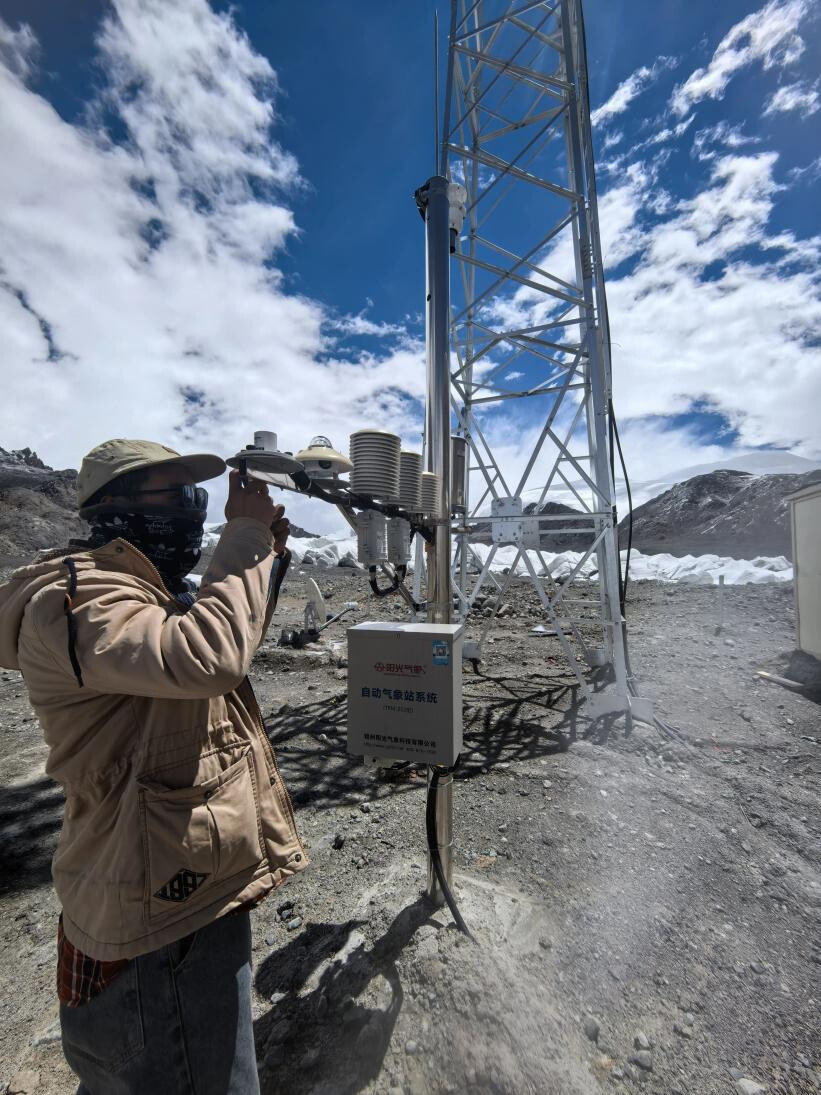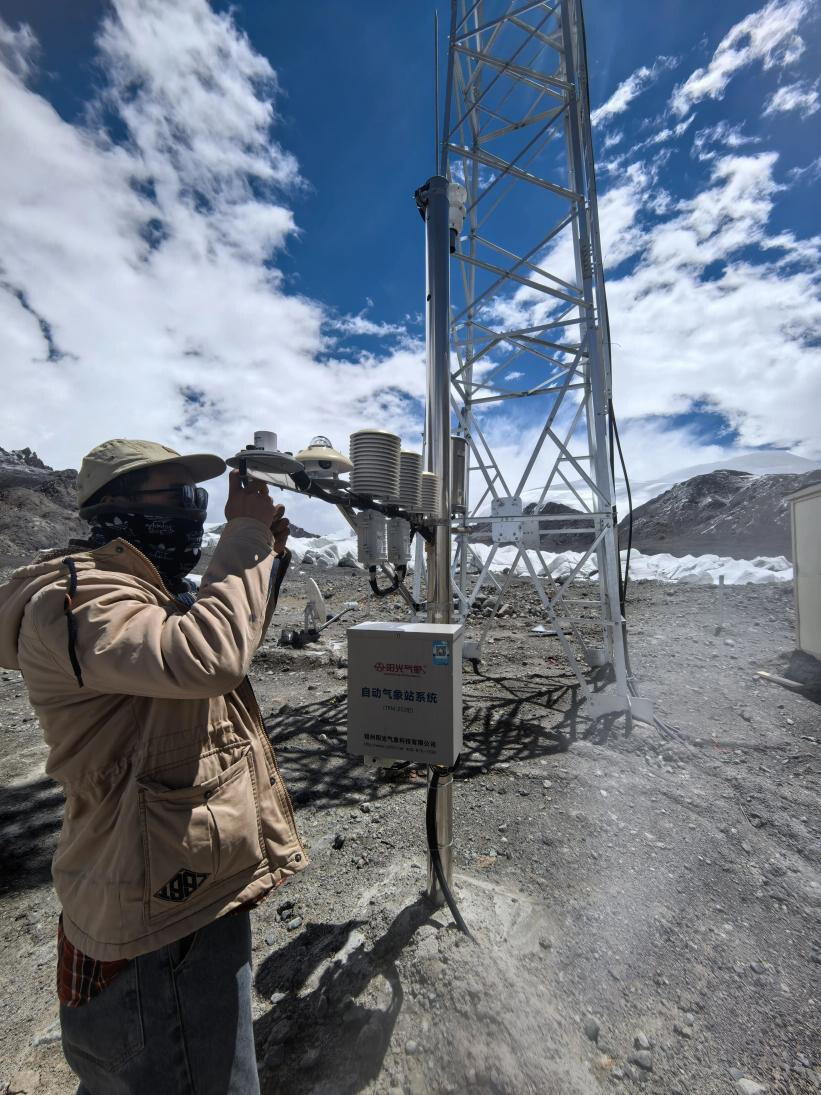By Li Hongmei, People's Daily

A technician performs maintenance at an automatic weather station in Amdo county. (Photo courtesy of the meteorological bureau of Amdo county)
Over five hours northbound by train from Lhasa, in southwest China's Xizang autonomous region, the landscape ascends steadily toward the Tanggula Mountains, reaching an altitude of 4,800 meters.
Nestled on the southern slopes of this formidable range is the Amdo meteorological station in Nagqu, officially recognized as the world's highest manned weather station. Often referred to as "the No. 1 Meteorological Station Under Heaven," it has quietly stood sentinel for nearly six decades.
The station's origins date back to 1965, when meteorologist Chen Jinshui and a colleague pitched two tents on a desolate hillside to begin systematic weather observation. Since then, generations of meteorological workers have remained steadfast at this remote outpost, braving extreme cold and oxygen scarcity to monitor climatic patterns on the Qinghai-Xizang Plateau, making invaluable contributions to the research on global climate change.
Situated in one of the world's largest mid- to low-latitude permafrost zones, Amdo experiences more than 140 days of strong winds above force eight each year, with gusts reaching more than 40 meters per second. The average annual temperature hovers at minus 2.8 degrees Celsius, with winter lows plunging to minus 43.2 degrees Celsius. Snow falls on approximately 109 days each year on average.
Even in June, the biting cold lingers. Locals bundle up in down jackets as gale-force winds, torrential rains, and hailstorms remain frequent. With over 90 days of thunderstorms and more than 70 days of hail annually, Amdo ranks first nationwide for both.
For station staff, the most formidable challenge is not the weather but the extreme high-altitude environment. Chronic headaches, chest tightness, and insomnia are commonplace, while prolonged exposure often leads to severe altitude-related illnesses.
Zhang Xiaoxing, a 31-year-old meteorologist from southwest China's Yunnan province, came to Amdo in 2022 to contribute to China's western development. Since arriving, altitude sickness has made insomnia routine. Yet Zhang remains resolute: "Unless health forces me to leave permanently, I'll stay. I aim to put down roots in the west and serve this land."
According to Dondrup Tsering, deputy head of the meteorological bureau of Amdo county, living and working conditions have significantly improved. Dormitories and offices are now equipped with oxygen supply systems and central heating. "Besides better living conditions and higher wages, we now have a job rotation system. Staff can transfer after five years," he explained.
Amdo is also traversed by two iconic routes known as "highland sky roads": China National Highway 109 (Qinghai-Xizang Highway) and the Qinghai-Xizang Railway.
Highway 109 is a crucial lifeline for the region, transporting over 80 percent of Xizang's inbound and outbound goods. It crosses the high-altitude Tanggula Mountain pass and runs through extensive permafrost zones, where cold, thin air is the norm.
From late March to early May each year, frequent rainfall is common, while heavy snow from November to early December often causes traffic disruptions. Under such extreme conditions, even minor delays can pose significant risks. Maintaining highway operation has thereby become a key responsibility of local meteorological authorities.
To meet this challenge, four dedicated road weather monitoring stations have been established along the Tanggula Mountains. Real-time data collection and timely forecasts and alerts play a vital role in easing traffic flow and safeguarding the lives of drivers and passengers.
On June 15, for instance, a specialized weather bulletin issued to the command center of a major highway upgrade project forecast rain and snow along the Gongma-Amdo section of Highway 109, along with possible thunderstorms on the afternoon of June 17. The forecast proved accurate: a violent thunderstorm accompanied by hail struck at around 3 p.m. on June 17. Thanks to the early warning, emergency protocols were activated in advance, minimizing disruption and damage.
At such extreme elevations, the consistently low pressure, subzero temperatures, and powerful winds place immense strain on weather monitoring systems, which frequently malfunction or encounter data transmission issues. Regular maintenance is essential.
"Every time we head out for maintenance, the wind is at least force seven," said Dondrup Tsering. "We typically wear a down jacket underneath and a thick military coat on top. Otherwise, the cold and wind would be unbearable." When temperatures drop too low, team members take turns checking equipment to minimize exposure. But during intricate repairs, gloves must be removed - exposing workers to the risk of frostbite.
When Tsering first joined the meteorological bureau of Amdo county in 2018, there were only three weather stations. That number has since grown to 28. Still, the vast terrain, high altitude, and unpredictable weather conditions make it difficult to capture all meteorological variables with precision.
But progress is underway. "We're accelerating the construction of new meteorological stations and expanding the observation network to better support forecasting and early warning," Tsering said. "We're working to improve forecast accuracy so we can better serve local development."
Nestled on the southern slopes of this formidable range is the Amdo meteorological station in Nagqu, officially recognized as the world's highest manned weather station. Often referred to as "the No. 1 Meteorological Station Under Heaven," it has quietly stood sentinel for nearly six decades.
The station's origins date back to 1965, when meteorologist Chen Jinshui and a colleague pitched two tents on a desolate hillside to begin systematic weather observation. Since then, generations of meteorological workers have remained steadfast at this remote outpost, braving extreme cold and oxygen scarcity to monitor climatic patterns on the Qinghai-Xizang Plateau, making invaluable contributions to the research on global climate change.
Situated in one of the world's largest mid- to low-latitude permafrost zones, Amdo experiences more than 140 days of strong winds above force eight each year, with gusts reaching more than 40 meters per second. The average annual temperature hovers at minus 2.8 degrees Celsius, with winter lows plunging to minus 43.2 degrees Celsius. Snow falls on approximately 109 days each year on average.
Even in June, the biting cold lingers. Locals bundle up in down jackets as gale-force winds, torrential rains, and hailstorms remain frequent. With over 90 days of thunderstorms and more than 70 days of hail annually, Amdo ranks first nationwide for both.
For station staff, the most formidable challenge is not the weather but the extreme high-altitude environment. Chronic headaches, chest tightness, and insomnia are commonplace, while prolonged exposure often leads to severe altitude-related illnesses.
Zhang Xiaoxing, a 31-year-old meteorologist from southwest China's Yunnan province, came to Amdo in 2022 to contribute to China's western development. Since arriving, altitude sickness has made insomnia routine. Yet Zhang remains resolute: "Unless health forces me to leave permanently, I'll stay. I aim to put down roots in the west and serve this land."
According to Dondrup Tsering, deputy head of the meteorological bureau of Amdo county, living and working conditions have significantly improved. Dormitories and offices are now equipped with oxygen supply systems and central heating. "Besides better living conditions and higher wages, we now have a job rotation system. Staff can transfer after five years," he explained.
Amdo is also traversed by two iconic routes known as "highland sky roads": China National Highway 109 (Qinghai-Xizang Highway) and the Qinghai-Xizang Railway.
Highway 109 is a crucial lifeline for the region, transporting over 80 percent of Xizang's inbound and outbound goods. It crosses the high-altitude Tanggula Mountain pass and runs through extensive permafrost zones, where cold, thin air is the norm.
From late March to early May each year, frequent rainfall is common, while heavy snow from November to early December often causes traffic disruptions. Under such extreme conditions, even minor delays can pose significant risks. Maintaining highway operation has thereby become a key responsibility of local meteorological authorities.
To meet this challenge, four dedicated road weather monitoring stations have been established along the Tanggula Mountains. Real-time data collection and timely forecasts and alerts play a vital role in easing traffic flow and safeguarding the lives of drivers and passengers.
On June 15, for instance, a specialized weather bulletin issued to the command center of a major highway upgrade project forecast rain and snow along the Gongma-Amdo section of Highway 109, along with possible thunderstorms on the afternoon of June 17. The forecast proved accurate: a violent thunderstorm accompanied by hail struck at around 3 p.m. on June 17. Thanks to the early warning, emergency protocols were activated in advance, minimizing disruption and damage.
At such extreme elevations, the consistently low pressure, subzero temperatures, and powerful winds place immense strain on weather monitoring systems, which frequently malfunction or encounter data transmission issues. Regular maintenance is essential.
"Every time we head out for maintenance, the wind is at least force seven," said Dondrup Tsering. "We typically wear a down jacket underneath and a thick military coat on top. Otherwise, the cold and wind would be unbearable." When temperatures drop too low, team members take turns checking equipment to minimize exposure. But during intricate repairs, gloves must be removed - exposing workers to the risk of frostbite.
When Tsering first joined the meteorological bureau of Amdo county in 2018, there were only three weather stations. That number has since grown to 28. Still, the vast terrain, high altitude, and unpredictable weather conditions make it difficult to capture all meteorological variables with precision.
But progress is underway. "We're accelerating the construction of new meteorological stations and expanding the observation network to better support forecasting and early warning," Tsering said. "We're working to improve forecast accuracy so we can better serve local development."
 Menu
Menu
 At 4,800 meters above sea level, world's highest manned weather station stands vigil
At 4,800 meters above sea level, world's highest manned weather station stands vigil
















